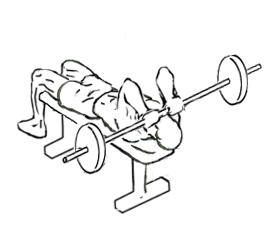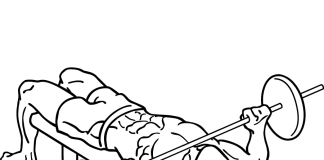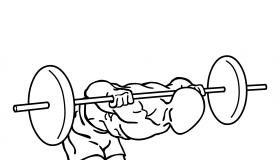Last Updated on September 24, 2014
The Lying Triceps Press with Barbell, also known as the French Press, is a classic exercise for those serious about building triceps strength and arm definition. This isolation exercise places direct tension on the triceps muscles, helping to grow the muscle’s size, improve arm aesthetics, and increase overall upper-body strength.
In this detailed guide, we’ll explore the proper form, benefits, variations, and common mistakes associated with the Lying Triceps Press with Barbell, providing you with all the information you need to make this exercise a staple in your arm day workouts.
Why the Lying Triceps Press is Essential
Triceps muscles make up the majority of the upper arm’s size, so focusing on exercises like the Lying Triceps Press can lead to noticeable gains. This exercise directly isolates the triceps, particularly the long head, maximizing engagement and muscle activation. It’s particularly beneficial for lifters looking to improve their pressing strength and upper-arm aesthetics, as well as for those training for sports that rely on arm power, such as swimming, basketball, and martial arts.
Anatomy of the Triceps
To understand why the Lying Triceps Press with Barbell is effective, it helps to look at the structure of the triceps. The triceps brachii, located at the back of the upper arm, consists of three heads:
- Long Head: Positioned along the back of the arm, the long head is primarily targeted in overhead extensions and exercises that bring the arm above the head.
- Lateral Head: Located on the outer part of the arm, this head gives the triceps its distinct shape, or “horseshoe” look.
- Medial Head: Found beneath the other two heads, the medial head assists in elbow extension and provides stability during arm movements.
The Lying Triceps Press with Barbell focuses on all three heads, with a specific emphasis on the long head due to the angle of movement, helping build both strength and size.
Step-by-Step Guide to Performing the Lying Triceps Press with Barbell
Step 1: Set Up Your Position
- Lie on a Flat Bench: Position yourself on a flat bench, with your head near one end. Keep your feet planted firmly on the floor to stabilize your body and prevent any shifting during the exercise.
- Select the Right Bar: You can use either a straight barbell or an EZ (curl) bar. The EZ bar is generally preferred as it allows for a more natural wrist position, reducing strain on the joints.
Step 2: Grip the Bar
- Grasp the Bar with an Overhand Grip: Use a shoulder-width overhand grip, with palms facing away from your body. Adjust your grip to ensure your wrists are straight and in line with your forearms, providing optimal stability.
- Position Your Elbows: Keep your elbows tucked in close to your body throughout the movement to prevent your shoulders from taking over and to maximize triceps isolation.
Step 3: Position the Barbell Overhead
- Raise the Barbell: Extend your arms so the barbell is directly above your shoulders. Your arms should be straight but avoid locking out the elbows, as this could place excessive strain on the joints.
- Engage Your Core: Tighten your core muscles to provide additional support to your lower back, especially if you’re lifting a heavier load.
Step 4: Lower the Barbell
- Move Only Your Elbows: Begin lowering the barbell in a controlled arc behind your head. Keep your upper arms and shoulders stationary while bending at the elbows to bring the barbell down.
- Go Slow and Controlled: Lower the bar until you feel a stretch in your triceps. Avoid going too low, as this may strain the shoulder joint.
Step 5: Return to the Starting Position
- Extend Through the Elbows: Press through your triceps to bring the bar back to the starting position, maintaining control of the barbell throughout the movement.
- Avoid Locking Out: At the top of the movement, keep a slight bend in your elbows to maintain tension on the triceps and protect the elbow joint.
Repeat for the desired number of reps, focusing on slow, controlled movements to maximize muscle activation.
Benefits of the Lying Triceps Press with Barbell
The Lying Triceps Press with Barbell provides several key benefits:
- Targeted Triceps Growth: This exercise isolates the triceps, allowing you to focus on this specific muscle group and promote hypertrophy (muscle growth).
- Improved Arm Strength and Aesthetics: Building strong triceps not only enhances upper-arm size and definition but also improves pressing strength for exercises like bench presses and shoulder presses.
- Greater Elbow Stability: The controlled movement strengthens the muscles and tendons around the elbow joint, supporting overall joint health.
- Enhanced Upper Body Control: Focusing on isolated triceps movements helps improve your mind-muscle connection and control over upper body movements.
Tips for Perfecting Your Form
Maintaining proper form is crucial for effective and safe triceps training. Here are some tips to help you get it right:
- Control the Descent: Avoid letting gravity pull the weight down too quickly. Control the lowering phase to increase time under tension and prevent injury.
- Focus on Elbow Position: Keep your elbows tucked in close to your body to maintain tension on the triceps and prevent shoulder strain.
- Avoid Locking Out: A slight bend in the elbows at the top of the movement keeps constant tension on the triceps.
- Watch Your Wrist Position: Avoid bending your wrists backward, which can cause strain. Maintain a firm, straight wrist position to protect your joints.
Common Mistakes and How to Avoid Them
Avoiding common errors in form is essential to get the most out of this exercise and prevent injury:
- Using Too Much Weight: It’s tempting to go heavy, but excess weight can compromise form and place undue stress on the shoulders and elbows. Focus on moderate weights and form instead.
- Flaring the Elbows: Flaring the elbows outward shifts tension away from the triceps and can strain the shoulders. Keep elbows tucked close to your body.
- Rushing the Movement: Performing the exercise too quickly reduces muscle activation and increases the risk of injury. Take your time to control each phase.
- Overextending Behind the Head: Lower the barbell only to a point where you feel a stretch in the triceps without straining the shoulders.
Variations of the Lying Triceps Press
To keep your workouts challenging and engage the triceps in different ways, try these variations:
1. Single-Arm Lying Triceps Extension
Use a single dumbbell instead of a barbell and perform the exercise one arm at a time. This variation increases core engagement and helps correct muscle imbalances between arms.
2. Incline Lying Triceps Press
Lie on an incline bench instead of a flat bench. The angle shifts more tension to the long head of the triceps, adding variety and challenge to the exercise.
3. Reverse Grip Lying Triceps Press
Use a reverse (underhand) grip on the bar. This grip emphasizes the medial head of the triceps and can be less stressful on the wrist joints.
4. Skull Crushers
Perform the same movement, but lower the barbell directly over your forehead instead of behind your head. This variation keeps the tension on the triceps while minimizing shoulder involvement.
Sample Workout Routine with Lying Triceps Press
Here’s a triceps-focused routine that incorporates the Lying Triceps Press with Barbell:
- Warm-Up: 5-10 minutes of cardio and dynamic stretching for the upper body.
- Triceps Pushdown (Cable): 3 sets of 10-12 reps
- Overhead Triceps Extension (Dumbbell): 3 sets of 8-10 reps
- Lying Triceps Press with Barbell: 3 sets of 8-12 reps, focusing on controlled movement
- Dips: 2 sets to failure for a final triceps burnout
Safety Tips
Since this exercise involves lifting weight above your head, it’s important to prioritize safety:
- Use a Spotter if Needed: For heavier weights, a spotter can provide assistance, particularly if you’re nearing fatigue.
- Start Light: Begin with a lighter weight to get comfortable with the movement, and gradually increase the weight as your strength and form improve.
- Avoid When Fatigued: If you’re feeling tired, skip this exercise, as it demands focus and control. Fatigue increases the risk of dropping the barbell.
Progressive Overload Techniques
For consistent gains, apply progressive overload to the Lying Triceps Press with Barbell:
- Increase the Weight: Gradually add weight in small increments once you’ve mastered the form.
- Increase Reps: Start with 8 reps and work up to 12 as you progress.
- Add a Pause: Pause briefly at the bottom of each rep to increase time under tension.
Incorporating the Exercise into Different Workouts
The Lying Triceps Press with Barbell can be integrated into various training splits:
- Push Day: Pair with chest and shoulder exercises for a complete upper-body workout.
- Arm Day: Combine with biceps exercises to build balanced upper-arm strength and size.
- Upper Body Day: Mix with other compound upper-body exercises like bench presses, rows, or shoulder presses. This ensures the triceps receive focused isolation work while also supporting compound movements that use the triceps as secondary muscles.
Integrating the Lying Triceps Press with Barbell into different workouts provides versatility in your training routine and allows you to hit the triceps from different angles, ultimately enhancing muscle growth and strength.
Tracking Your Progress
Tracking your performance with the Lying Triceps Press with Barbell can help you see gradual improvement and stay motivated. Consider tracking:
- Reps and Sets: Document the number of reps and sets you complete at each weight level. Increasing either over time is a clear sign of strength gains.
- Weight Used: Gradually increase the weight as your triceps adapt and grow stronger. Small increments, like 2.5 to 5 pounds, can make a big difference in progression.
- Tempo and Control: Note if you experiment with different tempos, such as slowing down the lowering phase to increase time under tension. This can help you control muscle fatigue and optimize growth.
- Form Adjustments: Keep track of any form corrections, such as elbow positioning or shoulder stability, so that each workout builds on good habits and reduces the risk of injury.
- Range of Motion: Pay attention to how deep you can lower the barbell without discomfort, especially as flexibility and strength improve. A controlled and consistent range of motion contributes to more effective muscle engagement.
Frequently Asked Questions (FAQs)
1. Can beginners perform the Lying Triceps Press with Barbell?
- Beginners can try this exercise with a lighter barbell or even dumbbells if they’re comfortable with their triceps strength. It’s crucial for beginners to prioritize form and start with manageable weights to avoid shoulder strain.
2. Is it better to use an EZ bar or a straight bar?
- An EZ (curl) bar is often more comfortable for the wrists and reduces stress on the joints, making it the preferred choice for many lifters. However, if a straight bar feels comfortable and stable for you, it’s also effective.
3. How often should I do the Lying Triceps Press with Barbell?
- Including this exercise in your workout once or twice a week is typically sufficient, especially when combined with other triceps and upper-body exercises. Overworking the triceps can lead to fatigue, so ensure they have time to recover between sessions.
4. Can I perform this exercise at home without a bench?
- Yes, but you’ll need a flat, stable surface where you can lie down safely. Using a yoga mat or sturdy floor area may work, but a bench provides the best support and range of motion.
5. What should I do if my elbows feel uncomfortable?
- If you experience elbow discomfort, check your form to ensure your elbows are tucked in and not flaring outward. You may also consider using an EZ bar for a more natural grip, or reduce the weight and focus on building strength gradually.
Final Thoughts
The Lying Triceps Press with Barbell (French Press) is a powerful exercise for targeting the triceps, especially the long head, which is essential for building a well-defined and strong upper arm. Whether you’re a beginner or an experienced lifter, this exercise offers significant benefits for muscle growth, strength, and joint stability when performed correctly.
By focusing on proper form, gradually increasing resistance, and integrating this exercise with other upper-body and triceps workouts, you’ll maximize your gains and build stronger, more defined triceps. Remember to take it slow, prioritize safety, and enjoy the journey to greater strength and enhanced arm aesthetics. With consistency and patience, the Lying Triceps Press with Barbell will soon become a key contributor to your arm training success.








